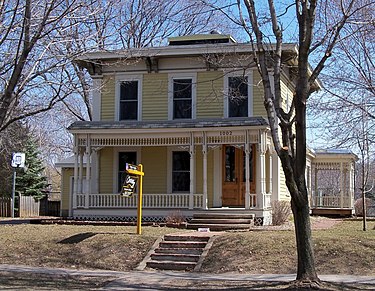Do you ever go wandering down the rabbit hole of looking at old houses online? Do you hop onto Pinterest or Facebook into those pages that have you wandering through photographs of the insides of homes and castles and all the cool old buildings? Or do you yourself live in one of those Victorian masterpieces? If you do, I'd love to hear about it!
Occasionally, while writing a novel, I spend time either online or by driving around neighborhoods in my story setting, hoping for likely homes my characters might reside in, or deciding where an imaginary home could be placed. This was especially fun to do when I wrote Polly (Apron Strings, Book One), and part of the reason why I chose Hudson, Wisconsin, as my story's location, rather than one of the other small towns along the northern Mississippi.
In fact, Hudson is located on the St. Croix River, where it flows from northern Wisconsin and then meets the mighty Mississippi. The Willow River is a tributary of the St. Croix which also conjoins there, offering a state park with scenic trails and views of graceful waterfalls, as well as good fishing.
This confluence of navigable rivers is the location early settlers chose to establish a trading post first, and later, lumber mills. As the setting was so prime for the development of the lumber and railroad industries, and so conveniently located to nearby developing St. Paul, it became a natural place for wealthy businessmen and founders to build stately homes, a number of which have been added to the Register of Historic Places. Let's take a look at a few of them.
 |
| Fredric L. Darling House / Darling-O'Brien House |
The first we'll visit is the Fredric L. Darling House, built in 1857 by architects Amasah and Ammah Andrews. The Andrews twins were transplants from New York, and it was said that their style "Hellenized Hudson". They built this home for Mr. Silas Staples the same year that Hudson was incorporated into a city.
When Darling died in 1899, having become known as a gentleman merchant and one of the last pioneer merchants of the county, the home came into the hands of cigarmaker and insurance man-turned-county sheriff, Cornelius O'Brien, and has remained in the O'Brien family. So the home eventually became known as the Darling-O'Brien House.
The home's style is Greek Revival. It stands in an L-shape two stories above a stone foundation. The style is most notable for it's gable portico and four octagonal columns.
 |
| Herman L. Humphrey House |
And then there are the Grand Dames of the town. First, there's the Phipps mansion:
 |
| William H. Phipps House - Phipps Inn Bed & Breakfast |
One of Hudson's prizes is the William H. Phipps house, a beautiful, Queen Anne Victorian now operating as a B&B. Here are a just a few of the interior photos from Trip Advisor.
 |
| The John S. Moffat House - Octagon House Museum |
The John S. Moffat House, Hudson's Octagon House (not to be confused with the Watertown, Wisconsin Octagon House) was built in 1855 by Judge John Shaw Moffet. It is on beautiful grounds directly across the road from the Phipps house, and is surrounded by garden landscape, garden house, and carriage house.
John Shaw Moffet worked in New York primarily as a storekeeper until 1854. Then, on the advice of his brother-in-law he emigrated to Hudson, Wisconsin. He arrived with his wife and ten-year-old daughter by train, riverboat, and lastly horse and wagon (much like the journey of characters in my novel The Green Veil, Empire in Pine, Book One, who came from Michigan to the Wisconsin woods).
Shortly after arriving, he became a police justice in Hudson. In 1867, he was admitted to the bar, and he became a county judge in 1869, a position he held until 1877. While a judge, in 1871, he went into a law partnership with his son-in-law, Thomas Hughes. Moffat practiced law until his death in 1903. But that's not all. He also became director and later president of the Hudson/St. Croix Valley Produce Company.The exterior of Polly's Queen Anne is a painted in various shades of beige with white trim. Do you find the Queen Anne style to be romantic, or would you prefer something more like the Italianate, or something as unique as an octagon house? Or something else entirely?
















.jpg)





















.jpg)





_(14576878567).jpg)
_-_Vonnegut.jpg)

